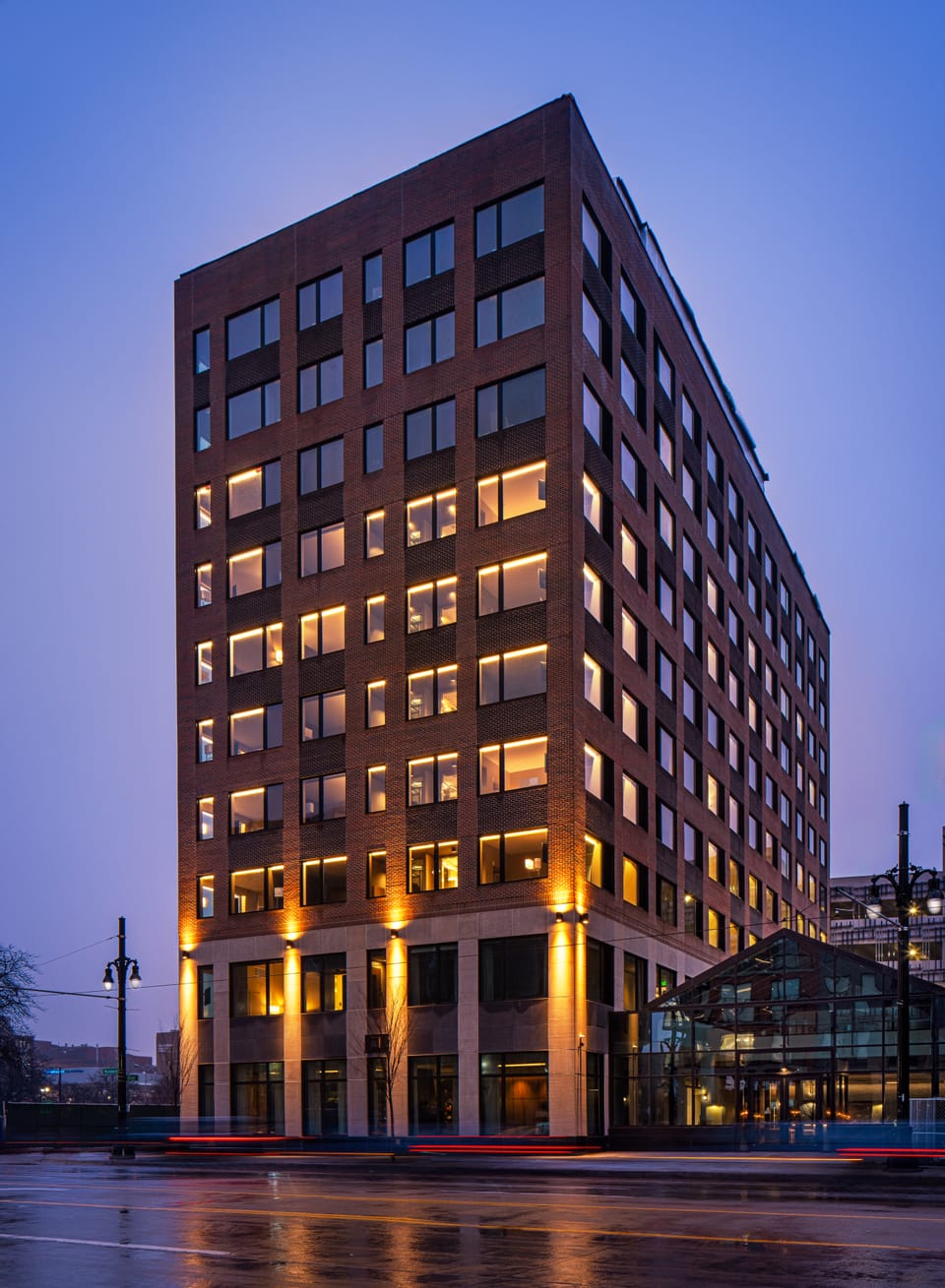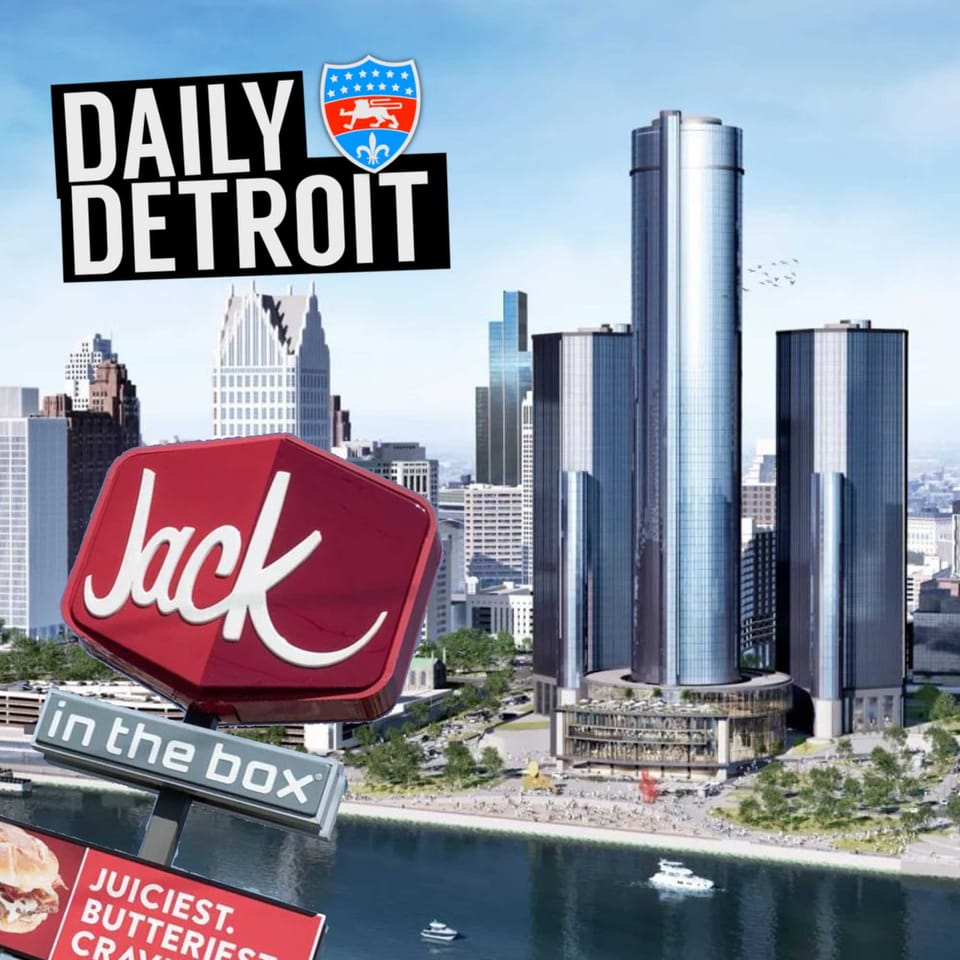A controversial window graphic has intensified a conversation in the Detroit community about race and inclusion on the 50th anniversary of the events of 1967.
Let’s set the table.
Bedrock, a real estate company owned by the billionaire founder of Quicken Loans, Dan Gilbert, owns the Vinton building. The Vinton was built in 1917 designed by Albert Kahn. It has sat vacant for awhile and has a litany of failed redevelopment attempts over the years, and is currently being redeveloped into apartments, including a penthouse with a private deck. At the corner of Woodward and Congress, it’s in a prime location and is very visible.
It’s not clear exactly when this graphic went up, but the photo in it looks to be from a party in The Belt, a newer alleyway lined with a gallery and some bars, in June of 2016. We were there for the Lupe Fiasco show that happened after the Detroit Party Marching band came through.
There are a few versions of the photo circulating online – one with a black and white tint that shows only part of the window, but here it is whole.
Detroit is 85% Black.
This poster is 0% Black. pic.twitter.com/zsro697ZYN
— Khaled Beydoun (@KhaledBeydoun) July 23, 2017
It portrays an almost lily-white scene in a city that’s 80% or so Black and 90% People of Color (when you count the hispanic and other non-white populations) paired with the words, “See Detroit Like We Do.”
As of this writing, the offending graphic has been taken down. Here’s a picture from about 5 p.m. today.

The ad as presented felt like an example of a term called “psychological gentrification.” I first heard of this term during a Michigan Citizen panel I attended on changes in the city a few years ago from gallery owner George N’Namdi. It encapsulates well the power that ads and marketing have to make a population feel minimized and left out of their own home.
Here are his words from a Metro Times Q&A here to explain it:
Part of Detroit is having this urban soul, and a lot of times it’s like throwing out the baby with the wash, in a way. By losing that energy, you lose your sense of having input into their environment. Right now, Detroiters take a lot of responsibility in their environment. We don’t want it to change where they begin to feel like it’s not their city. That’s what I mean by psychological gentrification. You go into places, you’re not seeing yourself as often. The different types of business that may be coming in, they may not be catering to you. I think that’s what you can kind of see. I think having that total input is very important.
People really love this city, and they want to be part of this city and any development. In speaking with the African-American community here — this is applicable to all the different communities — it’s that you always have a sense of self and a sense of importance as part of Detroit. If too much is done to give you the illusion or the sense that it’s not yours any longer, then you begin to have the feeling of being left out.
The underlying issues here are bigger than one company, and the timing of this gaffe matters.
First, the timing. This week is the 50th Anniversary of an event – whether you call it a riot or a rebellion – that was the physical manifestation of forces that were already tearing our community apart.
Second, many of the same issues that were seething back then are seething now. Here are some facts.
- Detroit schools were terrible for the black kids in the system in 1967, and now, on balance, still are terrible.
- Most of the well-paying jobs in our region are unattainable to Detroit residents. Something like 80 percent of the jobs in downtown require a college degree or technical training, while only 13.5 percent of residents have it.
- The foreclosure crisis continues to ripple through our neighborhoods. The city is being laid flat with mass demolitions of buildings left behind and massive tax foreclosures still loom on the horizon each year.
- The Bedrock team has the power to successfully lobby Lansing and get new tax programs to rebuild the vacant Hudson’s site pushed through the legislature in a year, but car insurance reform that would be a huge economic bonus for the rest of the city sits stalled for years.
- Metro Detroit is the most segregated region in the country.
- National publications are hailing Dan Gilbert as the mayor of Detroit. That raises talk about questions of representation and who is actually in charge here. He has done a lot for the city, but nobody elected that guy.
You can debate the nitty gritty details, for sure. And these systemic issues aren’t one person’s fault. Our country continues to face a mostly ignored urban crisis, and as always, Detroit is a magnification of the issues facing America. It’s going to take major financial resources and focus to make a large difference in urban communities across our country – much, much more than the city government, or even the richest man in Michigan, has.
The folks at Bedrock, being the most visible and best financed developers in the city, should be aware of this complicated history and take it to account in their ads and messages, but their messaging seems to continually fall flat in the community.
There is plenty of local talent out there that could help them navigate these issues. I’ve heard from multiple sources over the last couple of years that various Rock companies have talked to professionals who could handle this, all of whom qualified to help, but always in the end feel tell those people thanks, but they’ve got it.
They don’t got it.
Everyone knows change in Detroit isn’t only coming, it’s already here. There are signs not just in downtown and Midtown, but in neighborhoods like Jefferson Chalmers, The Avenue of Fashion, Fitzgerald, among others.
The power and magic of Detroit and our comeback is in our people. We shouldn’t erase that. We should embrace it.














